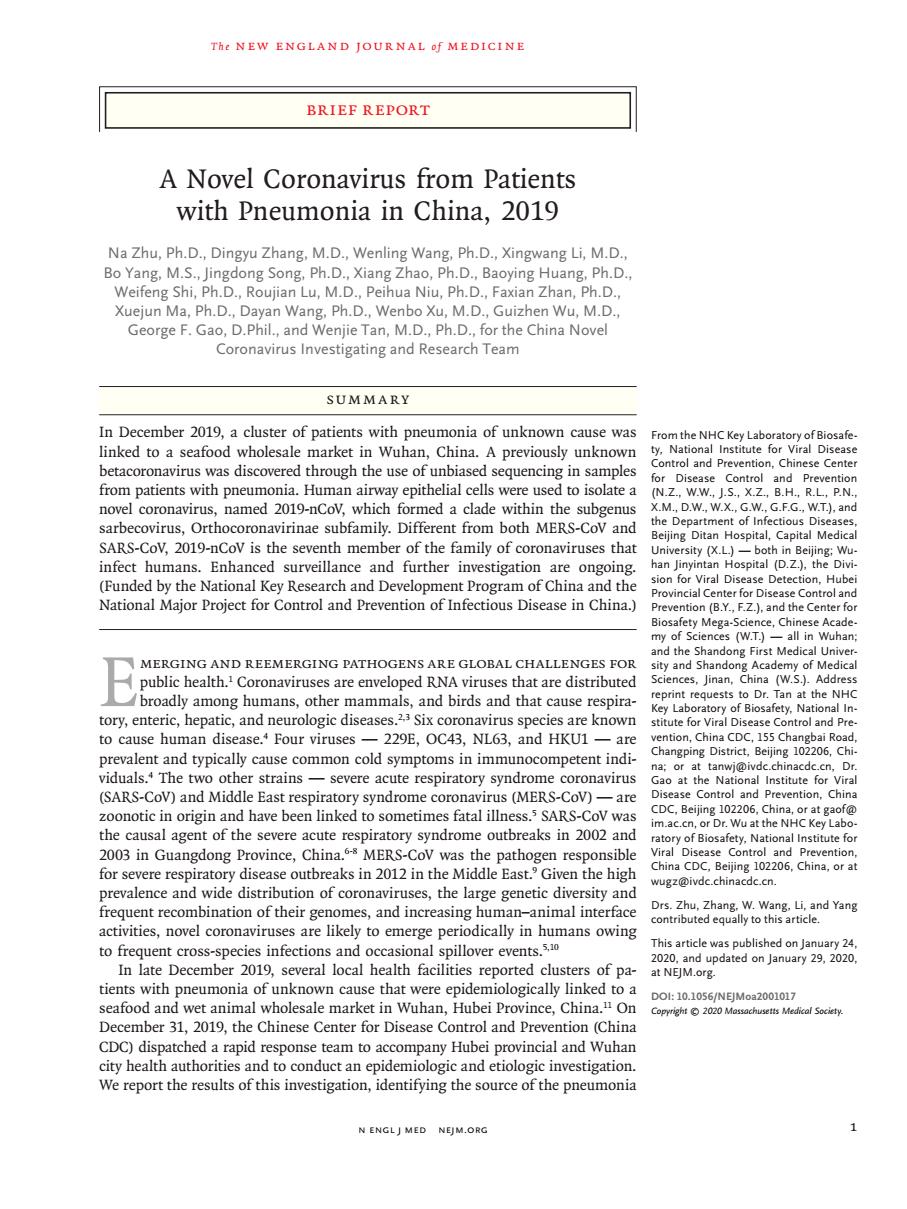正在加载图片...

The NEW ENGLAND JOURNAL Of MEDICINE BRIEF REPORT A Novel Coronavirus from Patients with Pneumonia in China,2019 NaZh,Ph.D..M.D.Wenling Wang.Ph.D.Li,M.D PhD Weifeng Shi,Ph.D..D Peihua Niu.Ph.zh Ph.D Xuejun Ma,Ph.D..Dayan Wang,Ph.D.,Wenbo Xu,M.D.,Guizhen Wu,M.D. George F.Gao,D.Phil.,and Wenjie Tan,M.D.,Ph.D.for the China Novel Coronavirus Investigating and Research Team SUMMARY In December 2019,a cluster of patients with pneumonia of unknown cause was linked to a seafood wholesale market in Wuhan,China.A previously unknown etacoronavirus was discovered t through the use of sequencing in sample from patients with pe d subfamily.Different from both MERS-CoV and SARS-CoV.2019-nCov is the seve nth member of the family of coronaviruses that infect humans.Enhanced surveillance and further investigation are ongoing (Funded by the National Key Research and Development Program of China and the National Major Project for Control and Prevention of Infectious Disease in China.) public health s are en broadly among humans,other mammals,and birds and that cause respira- tory,enteric,hepatic,and neurologic diseases. Six coronavirus species are known to cause human disease.Four viruses- 229E,OC43,NL63,and HKU1 prevalent nd typically cause ommon o (SARS-C severe ac tory syn otic in igin and have h or at gaot the causal agent of the severe acute respiratory syndrome outhreaks in 2002 and for severe respirat ing 10226.China. prevalence and wide distr tion of coronaviruses,the large genetic diversity and frequen adon of t omes,and increasin Yang hmans owing 02 of pa tients with pneumonia of unknown cause that were epidemiologically linked to seafood and wet animal wholesale market in Wuhan,Hubei Province,China."On December 31,2019,the Chinese Center for Disease Control and Prevention (C hina CDC dispatched a rapid sponse team to accompany Hub or report the source ofthe pneumon N ENGLJ MED NEJM.ORC The new england journal o f medicine n engl j med nejm.org 1 Brief Report Summary In December 2019, a cluster of patients with pneumonia of unknown cause was linked to a seafood wholesale market in Wuhan, China. A previously unknown betacoronavirus was discovered through the use of unbiased sequencing in samples from patients with pneumonia. Human airway epithelial cells were used to isolate a novel coronavirus, named 2019-nCoV, which formed a clade within the subgenus sarbecovirus, Orthocoronavirinae subfamily. Different from both MERS-CoV and SARS-CoV, 2019-nCoV is the seventh member of the family of coronaviruses that infect humans. Enhanced surveillance and further investigation are ongoing. (Funded by the National Key Research and Development Program of China and the National Major Project for Control and Prevention of Infectious Disease in China.) Emerging and reemerging pathogens are global challenges for public health.1 Coronaviruses are enveloped RNA viruses that are distributed broadly among humans, other mammals, and birds and that cause respiratory, enteric, hepatic, and neurologic diseases.2,3 Six coronavirus species are known to cause human disease.4 Four viruses — 229E, OC43, NL63, and HKU1 — are prevalent and typically cause common cold symptoms in immunocompetent individuals.4 The two other strains — severe acute respiratory syndrome coronavirus (SARS-CoV) and Middle East respiratory syndrome coronavirus (MERS-CoV) — are zoonotic in origin and have been linked to sometimes fatal illness.5 SARS-CoV was the causal agent of the severe acute respiratory syndrome outbreaks in 2002 and 2003 in Guangdong Province, China.6-8 MERS-CoV was the pathogen responsible for severe respiratory disease outbreaks in 2012 in the Middle East.9 Given the high prevalence and wide distribution of coronaviruses, the large genetic diversity and frequent recombination of their genomes, and increasing human–animal interface activities, novel coronaviruses are likely to emerge periodically in humans owing to frequent cross-species infections and occasional spillover events.5,10 In late December 2019, several local health facilities reported clusters of patients with pneumonia of unknown cause that were epidemiologically linked to a seafood and wet animal wholesale market in Wuhan, Hubei Province, China.11 On December 31, 2019, the Chinese Center for Disease Control and Prevention (China CDC) dispatched a rapid response team to accompany Hubei provincial and Wuhan city health authorities and to conduct an epidemiologic and etiologic investigation. We report the results of this investigation, identifying the source of the pneumonia From the NHC Key Laboratory of Biosafety, National Institute for Viral Disease Control and Prevention, Chinese Center for Disease Control and Prevention (N.Z., W.W., J.S., X.Z., B.H., R.L., P.N., X.M., D.W., W.X., G.W., G.F.G., W.T.), and the Department of Infectious Diseases, Beijing Ditan Hospital, Capital Medical University (X.L.) — both in Beijing; Wuhan Jinyintan Hospital (D.Z.), the Division for Viral Disease Detection, Hubei Provincial Center for Disease Control and Prevention (B.Y., F.Z.), and the Center for Biosafety Mega-Science, Chinese Academy of Sciences (W.T.) — all in Wuhan; and the Shandong First Medical University and Shandong Academy of Medical Sciences, Jinan, China (W.S.). Address reprint requests to Dr. Tan at the NHC Key Laboratory of Biosafety, National Institute for Viral Disease Control and Prevention, China CDC, 155 Changbai Road, Changping District, Beijing 102206, China; or at tanwj@ivdc.chinacdc.cn, Dr. Gao at the National Institute for Viral Disease Control and Prevention, China CDC, Beijing 102206, China, or at gaof@ im.ac.cn, or Dr. Wu at the NHC Key Laboratory of Biosafety, National Institute for Viral Disease Control and Prevention, China CDC, Beijing 102206, China, or at wugz@ivdc.chinacdc.cn. Drs. Zhu, Zhang, W. Wang, Li, and Yang contributed equally to this article. This article was published on January 24, 2020, and updated on January 29, 2020, at NEJM.org. DOI: 10.1056/NEJMoa2001017 Copyright © 2020 Massachusetts Medical Society. A Novel Coronavirus from Patients with Pneumonia in China, 2019 Na Zhu, Ph.D., Dingyu Zhang, M.D., Wenling Wang, Ph.D., Xingwang Li, M.D., Bo Yang, M.S., Jingdong Song, Ph.D., Xiang Zhao, Ph.D., Baoying Huang, Ph.D., Weifeng Shi, Ph.D., Roujian Lu, M.D., Peihua Niu, Ph.D., Faxian Zhan, Ph.D., Xuejun Ma, Ph.D., Dayan Wang, Ph.D., Wenbo Xu, M.D., Guizhen Wu, M.D., George F. Gao, D.Phil., and Wenjie Tan, M.D., Ph.D., for the China Novel Coronavirus Investigating and Research Team